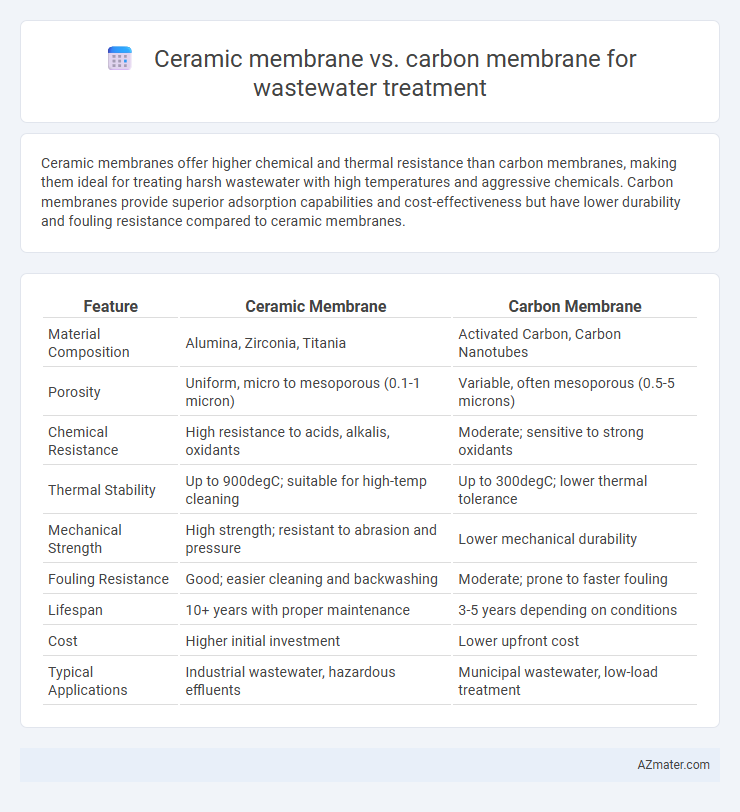Ceramic membranes offer higher chemical and thermal resistance than carbon membranes, making them ideal for treating harsh wastewater with high temperatures and aggressive chemicals. Carbon membranes provide superior adsorption capabilities and cost-effectiveness but have lower durability and fouling resistance compared to ceramic membranes.
Table of Comparison
| Feature | Ceramic Membrane | Carbon Membrane |
|---|---|---|
| Material Composition | Alumina, Zirconia, Titania | Activated Carbon, Carbon Nanotubes |
| Porosity | Uniform, micro to mesoporous (0.1-1 micron) | Variable, often mesoporous (0.5-5 microns) |
| Chemical Resistance | High resistance to acids, alkalis, oxidants | Moderate; sensitive to strong oxidants |
| Thermal Stability | Up to 900degC; suitable for high-temp cleaning | Up to 300degC; lower thermal tolerance |
| Mechanical Strength | High strength; resistant to abrasion and pressure | Lower mechanical durability |
| Fouling Resistance | Good; easier cleaning and backwashing | Moderate; prone to faster fouling |
| Lifespan | 10+ years with proper maintenance | 3-5 years depending on conditions |
| Cost | Higher initial investment | Lower upfront cost |
| Typical Applications | Industrial wastewater, hazardous effluents | Municipal wastewater, low-load treatment |
Introduction to Membrane Technologies in Wastewater Treatment
Ceramic membranes offer superior chemical and thermal stability, making them ideal for harsh wastewater treatment conditions compared to carbon membranes, which excel in adsorption capabilities due to their porous structure. Both membrane types utilize filtration mechanisms to remove suspended solids, organic matter, and contaminants, with ceramic membranes providing higher durability and longer service life. Advances in membrane technologies enhance wastewater treatment efficiency by enabling selective separation and reducing operational costs through improved fouling resistance and regeneration potential.
Overview of Ceramic Membranes: Composition and Characteristics
Ceramic membranes, composed primarily of materials such as alumina, zirconia, and titania, exhibit exceptional chemical, thermal, and mechanical stability ideal for wastewater treatment applications. These membranes feature a porous structure with uniform pore size distribution, enabling effective filtration of contaminants including suspended solids, bacteria, and viruses. Their robustness against harsh pH levels and high temperatures enhances durability and performance compared to conventional organic membranes like carbon membranes.
Overview of Carbon Membranes: Structure and Properties
Carbon membranes for wastewater treatment feature a porous structure composed primarily of carbon fibers or carbon nanotubes, offering high surface area and exceptional mechanical strength. These membranes exhibit excellent chemical resistance and thermal stability, making them suitable for harsh wastewater conditions. Their inherent hydrophobicity and tunable pore size distribution enhance selective separation and flux rates, improving contaminant removal efficiency.
Filtration Efficiency: Ceramic vs. Carbon Membranes
Ceramic membranes exhibit superior filtration efficiency compared to carbon membranes due to their uniform pore size distribution and higher chemical resistance, enabling them to remove smaller particles and contaminants in wastewater treatment. Carbon membranes tend to have lower flux rates and are less effective in retaining fine suspended solids and microorganisms, limiting their performance in high-turbidity wastewater. The durability and fouling resistance of ceramic membranes also contribute to sustained high filtration efficiency over prolonged operational periods.
Chemical and Thermal Stability Comparison
Ceramic membranes exhibit superior chemical and thermal stability compared to carbon membranes, making them highly suitable for harsh wastewater treatment conditions involving strong acids, alkalis, and high temperatures up to 600degC. Carbon membranes, while cost-effective and efficient for organic compound removal, typically degrade under extreme pH levels and temperatures above 200degC, limiting their application scope. The robust inorganic structure of ceramic membranes ensures long-term durability and consistent performance in chemically aggressive and thermally demanding wastewater environments.
Fouling Resistance: Performance in Real Wastewater Scenarios
Ceramic membranes exhibit superior fouling resistance compared to carbon membranes in real wastewater scenarios due to their robust chemical and thermal stability, enabling efficient removal of organic and inorganic contaminants. Their traditional inorganic composition and precise pore size control reduce biofouling and scaling, maintaining higher flux and longer operational lifespan under harsh conditions. Carbon membranes, while effective in adsorption, tend to experience rapid fouling and reduced permeability, limiting their practical application for extended wastewater treatment processes.
Lifespan and Maintenance Requirements
Ceramic membranes exhibit a significantly longer lifespan, often exceeding 10 years due to their high chemical and thermal stability, while carbon membranes typically last around 3 to 5 years before replacement is necessary. Maintenance for ceramic membranes is less frequent and simpler, as they resist fouling and withstand aggressive cleaning methods, whereas carbon membranes require more regular cleaning and careful handling to avoid damage. The enhanced durability of ceramic membranes reduces overall operational costs in wastewater treatment applications despite their higher initial investment.
Cost-Effectiveness and Scalability Analysis
Ceramic membranes exhibit higher upfront costs due to advanced material properties but offer superior durability, chemical resistance, and longer lifespan, enhancing long-term cost-effectiveness in wastewater treatment applications. Carbon membranes, while initially more affordable, may incur higher operational and replacement expenses owing to lower chemical stability and shorter service life, impacting their scalability in large-scale or harsh environmental conditions. Scaling ceramic membranes is often more viable for extensive industrial wastewater treatment, whereas carbon membranes suit smaller-scale or less aggressive treatment scenarios where budget constraints dominate.
Environmental Impact and Sustainability Considerations
Ceramic membranes offer higher chemical resistance and longer lifespan, reducing the frequency of replacements and lowering environmental waste compared to carbon membranes. Carbon membranes require less energy for production but tend to have shorter durability, leading to increased material usage and disposal concerns. The sustainability of ceramic membranes is enhanced by their ability to withstand harsh cleaning processes, enabling effective reuse and minimizing environmental footprint.
Final Recommendation: Choosing the Right Membrane for Wastewater Treatment
Ceramic membranes offer superior chemical resistance, high-temperature tolerance, and longer lifespan, making them ideal for treating industrial wastewater with harsh conditions. Carbon membranes excel in organic pollutant removal and are cost-effective for municipal wastewater applications but have lower durability and chemical stability. Selecting the right membrane depends on specific wastewater characteristics, with ceramic membranes recommended for aggressive contaminants and carbon membranes suitable for less demanding, organic-rich effluents.

Infographic: Ceramic membrane vs Carbon membrane for Wastewater treatment
 azmater.com
azmater.com